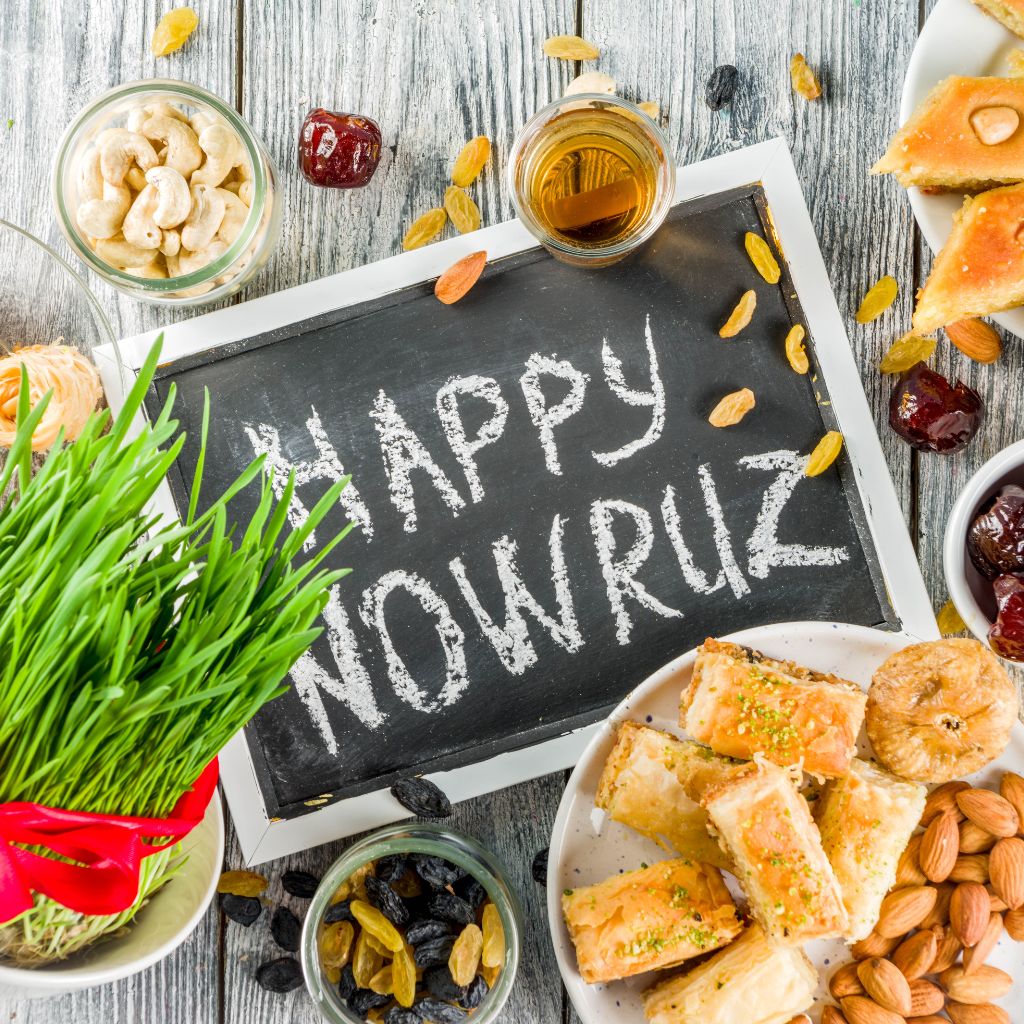
Nowruz, meaning “New Day” in Persian, is the ancient festival marking the Persian New Year and the arrival of spring. Rooted in Zoroastrian traditions and observed for over 3,000 years, Nowruz is celebrated by millions of people across Iran, Central Asia, the Caucasus, the Middle East, and parts of South Asia and the Balkans. This joyous occasion symbolizes renewal, hope, and the triumph of light over darkness, as it aligns with the spring equinox, typically occurring on March 20 or 21.
Nowruz meaning in Hindi:
नवरोज़, जिसे फारसी में “नया दिन” कहा जाता है, ईरानी नववर्ष है, जो वसंत विषुव के साथ शुरू होता है और दुनिया भर में ईरानियों और पारसी समुदाय द्वारा मनाया जाता है.
यहाँ नवरोज़ के बारे में कुछ और जानकारी दी गई है:
- अर्थ:नवरोज़ का शाब्दिक अर्थ है “नया दिन”.
- समय:यह आमतौर पर 21 मार्च को मनाया जाता है, जो वसंत विषुव का दिन है.
- महत्व:नवरोज़ प्रकृति प्रेम का उत्सव है, जो सर्दियों के अंत और वसंत के आगमन का प्रतीक है.
- पारसी नववर्ष:नवरोज़ पारसी नववर्ष की शुरुआत का प्रतीक है.
- उत्सव:नवरोज़ के दौरान, लोग घरों की सफाई करते हैं, रंगोली बनाते हैं, और एक-दूसरे को शुभकामनाएं देते हैं.
- अन्य नाम:इसे जमशेदी नवरोज़, पतेती और पारसी नव वर्ष के तौर पर भी जाना जाता है.
- वैश्विक मान्यता:2009 में यूनेस्को ने नवरोज़ को भारत की अमूर्त सांस्कृतिक विरासत की सूची में शामिल किया था.
- ईरान में:नवरोज़ ईरान में एक सार्वजनिक अवकाश है और सांस्कृतिक परंपराओं में गहराई से समाया हुआ है.
- भारत में:भारत में, नवरोज़ को पारसी समुदाय द्वारा मनाया जाता है.
- अन्य समुदाय:दुनिया भर में, कई अन्य समुदाय भी नवरोज़ को मनाते हैं, जैसे कि इस्माइली मुसलमान.
- इतिहास:नवरोज़ की परंपरा लगभग 3000 वर्ष पहले शुरू हुई थी.
- राजा जमशेद:नवरोज़ को फारसी राजा जमशेद के नाम पर भी जाना जाता है, जिन्होंने पारसी कैलेंडर पेश किया था.
The Historical and Cultural Significance of Nowruz
Nowruz dates back to the Achaemenid Empire (550–330 BCE) and is deeply connected to Zoroastrianism, one of the world’s oldest religions. The festival reflects the Zoroastrian belief in the duality of good and evil, as well as the importance of purifying oneself physically and spiritually to welcome a new cycle of life.
Over the centuries, Nowruz has transcended religious and national boundaries, becoming a unifying celebration for diverse communities, including Persians, Kurds, Afghans, Tajiks, Azerbaijanis, Uzbeks, and many others. In 2010, Nowruz was officially recognized by the United Nations as an Intangible Cultural Heritage of Humanity, highlighting its global significance.
Pre-Nowruz Traditions: Preparing for the New Year
Preparation for Nowruz begins weeks in advance with various customs that ensure a fresh start to the new year. Some of the most prominent pre-Nowruz traditions include:
1. Khooneh Tekouni (Spring Cleaning)

Families thoroughly clean their homes, symbolizing the removal of negativity and making space for positive energy. This practice is similar to the Western tradition of spring cleaning but holds deeper cultural and spiritual meanings.
2. Chaharshanbe Suri (Fire Jumping Festival)

Held on the last Wednesday before Nowruz, Chaharshanbe Suri involves lighting bonfires and jumping over flames while chanting, “Zardi man az to, sorkhi to az man” (May my paleness go to you, and your redness come to me). This ritual represents the purification of the soul and the hope for good health and fortune in the new year.
The Haft-Seen Table: A Symbolic Display
One of the most cherished Nowruz traditions is setting up the Haft-Seen table, which features seven symbolic items that start with the Persian letter “S” (س). Each item represents a different aspect of life and renewal:
- Sabzeh (Sprouted wheat or lentils) – Symbolizing rebirth and growth
- Samanu (Sweet wheat pudding) – Representing strength and prosperity
- Senjed (Dried oleaster fruit) – Signifying love and wisdom
- Seer (Garlic) – Denoting health and protection
- Seeb (Apple) – Symbolizing beauty and fertility
- Somāq (Sumac spice) – Representing the color of sunrise and patience
- Serkeh (Vinegar) – Signifying wisdom and aging
Additional items such as a mirror (reflection and self-awareness), candles (light and enlightenment), painted eggs (fertility), a goldfish (life and progress), and a book of poetry or the Quran (knowledge and faith) are also placed on the table.
Nowruz Festivities and Celebrations
On the day of Nowruz, families gather to exchange greetings, enjoy festive meals, and visit elders and loved ones. The celebration is accompanied by music, dance, and cultural performances.
A traditional Nowruz feast often includes dishes such as:
- Sabzi Polo ba Mahi (Herbed rice with fish)
- Kookoo Sabzi (Herb omelet)
- Reshteh Polo (Rice with noodles symbolizing life’s journey)




Sizdah Bedar: The Conclusion of Nowruz
The Nowruz festivities conclude on the 13th day of the new year, known as Sizdah Bedar. Families spend the day outdoors, picnicking and enjoying nature to ward off bad luck associated with the number 13. It is customary to release the sprouted Sabzeh into a body of water, symbolizing the return of life to nature and wishing for a prosperous year ahead.
The Global Impact of Nowruz
While Nowruz has its roots in Persian culture, it has evolved into an international celebration embraced by people of different backgrounds. Many countries recognize Nowruz as a public holiday, and in 2010, the United Nations declared March 21 as the International Day of Nowruz, emphasizing its role in fostering peace and cultural harmony.
Final Thoughts
Nowruz is more than just the beginning of a new year—it is a celebration of life, renewal, and unity. Through its ancient customs and traditions, it continues to bring people together across generations and cultures. Whether you celebrate Nowruz traditionally or simply embrace the spirit of spring renewal, this festival reminds us of the beauty of new beginnings and the hope for a brighter future.
Nowruz Mobarak! (Happy Nowruz!)